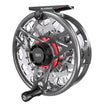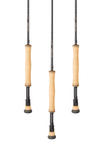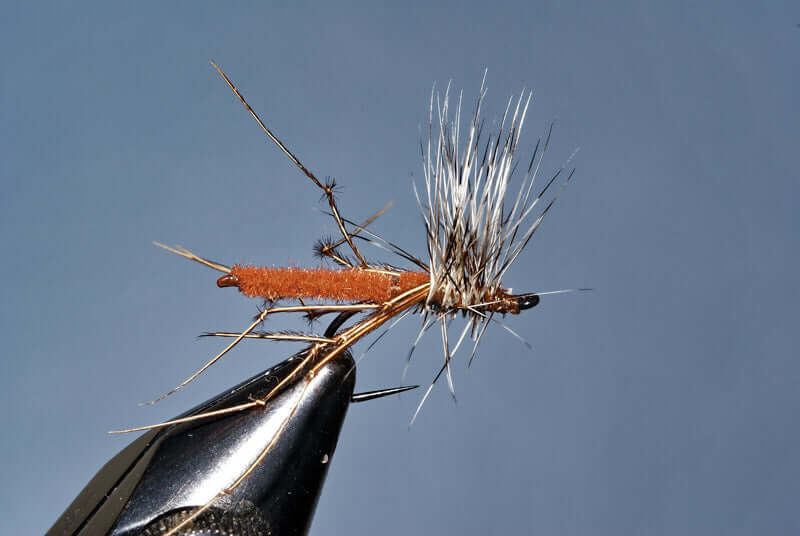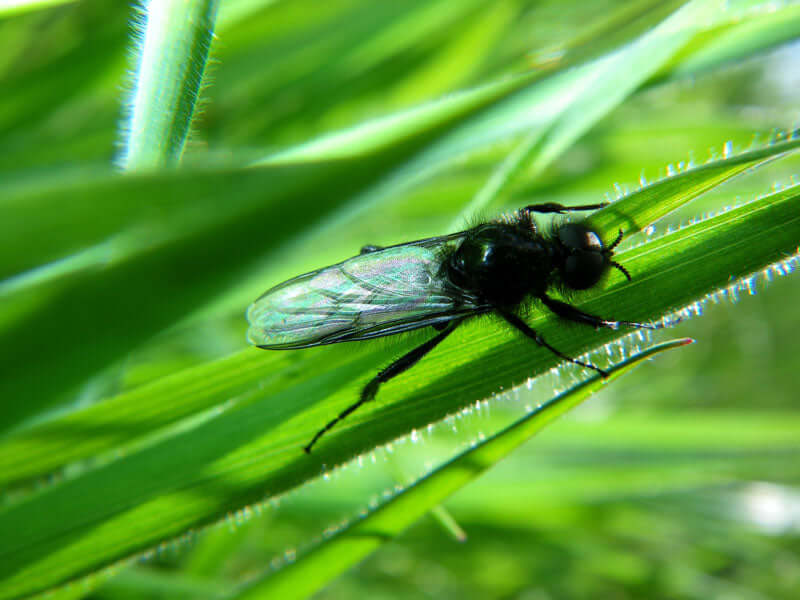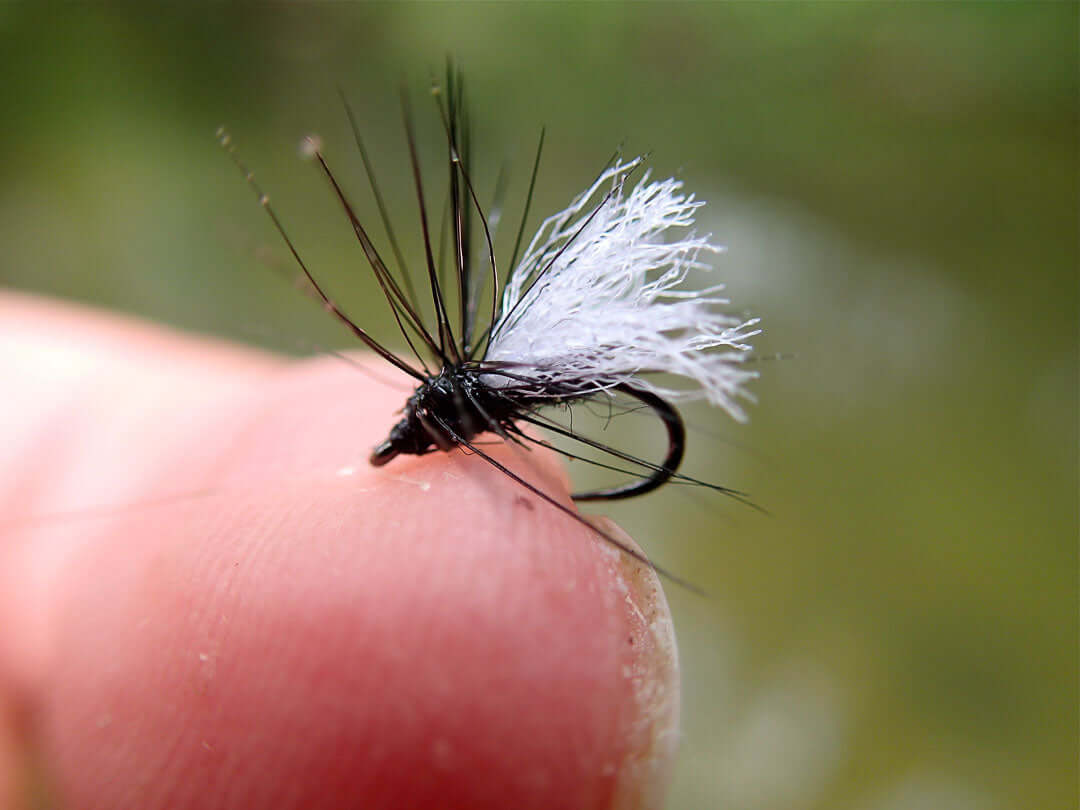Thanks to David Southall for this article.
Daddies on the dry
Little or nothing hatching? Few fish rising? With declining populations of Ephemerids (up-wing flies), this is an increasingly common scenario on many rivers. Even on my local Yorkshire Derwent, which still has healthy Ephemerid populations, there are times during May, June, July and August when hatches are sparse and surface activity minimal. It is then that terrestrials come into their own. On windy days, the windier the better, wooded sections of the river can provide a bonanza of dislodged beetles, wood ants and greenflies. Under these conditions the fish are usually opportunistic feeders, taking whatever fly is put over them. If it lands with a plop then ‘so much the better’. The choice of fly is yours; foam beetle, black klinkhåmer, sedge etc.. The following stomach analysis from a Yorkshire Derwent trout is typical of such days in August;
Flies in a trout's stomach
10 black gnats, 3 medium sized black Diptera (blue bottle type flies), 1 Ichneumon fly, 61 wood ants, 5 black beetles.
On calm days it can be very different. Few terrestrials are blown onto the water; there is no hatch and the river looks dead. What can the dry-fly fisher do? Do we walk for miles searching for a riser? Do we go home? Or do we go to the pub to drown our sorrows? No!!! Now is the time to use our watercraft and call on Daddy for help. Some people use a Sedge as their choice of “search-fly”, but my usual choice is the Daddy-long-legs for trout (not for grayling since they seem reticent about taking them).
How do I fish my Daddy?
...and why does he work so well? Many anglers will tell you that late summer is the Daddy season, but Crane flies are about from April till September. There are a number of species of Tipulids, to give them their scientific name. Many have aquatic larvae, which are to be found in virtually every kick sample I take from my local rivers whilst studying the riverbed invertebrates. The larvae are well imitated by a size 12 Sawyer’s Killer Bug. Although their size varies considerably, the adults are all substantial enough to tempt a fish to the surface and their feeble struggles in the surface film advertise their presence. Trout detect these vibrations with their lateral line pressure receptors. Although the fish don’t see them often (other than during the late summer glut), they certainly know what they are and rise to them with gusto. I usually fish them “dead drift”, but if this fails I give a short, sharp twitch or two. Takes to the twitched fly can be explosive so I step up to a 5lb plus tippet (4x). I must admit that “blind casting” is not my favourite style of fishing, but searching with a dry fly is the same as searching with a nymph. I look for the likely lies, where the current swings under trees, by roots or against steep banks. I also search the current seams/foam lines and in front of and behind boulders and weed beds, where there are steep drop offs or even where there are slight depressions in a shallow riffle. I never ignore the really “skinny” water, particularly in hot sunny conditions. The shallow riffles between pools are well oxygenated, whilst the rippled surface provides cover for the fish. Last summer I had 3 nice wildies from a tiny 12 inch deep pocket in a 6 inch deep riffle.
As an Entomologist I always try to fish appropriate imitative patterns, whether fishing wet or dry. The Daddy is one such pattern and I rather take him for granted. Still water fly-fishers are well aware of the value of the Daddy. However a few years ago I was reminded that some river anglers are not so familiar with his potential. It was a baking hot day on the Yorkshire Derwent; I was having a slow evening, with just a sprinkling of small fish falling to my size 16 paraloop red spinner. Not much was rising and there were only a few Yellow Mays, Olives and spinners about. A change to the twitched Daddy immediately brought improved success, with more and bigger fish coming to the net. That evening a friend rang for some advice. He too had found the fishing very slow. I suggested he try a Daddy next time and since he had none, I tied him up a few, which I delivered early the following day. He kindly exchanged them for a bottle of Chablis. That evening he phoned: he’d had a great session with the Daddy and informed me that there were plenty more bottles of wine if I had more Daddies to spare.
Forgotten your box of Mayflies or maybe you’ve lost your last Mayfly on an overhanging branch? It’s an afternoon in late May or early June and the trout are going mad on emerging Mayfly Duns. Don’t worry! I’ve done it a few times myself. Fortunately I’ve yet to find a trout feeding on Mayflies which won’t take a Daddy. They provide the same basic triggers. In fact early in a Mayfly hatch, when the trout are really slashing at the Mayflies but often missing them, I find I have far fewer missed takes if I use a Daddy.
Mid-summer and you’re on a still water. The trout are erupting after Damsel flies skimming the surface. You’ve no adult Damsel patterns!!! No worries; call on Daddy yet again. A Daddy skated across the surface works fine. Never mind that the Damsels are blue and your Daddy is brown; the trout don’t mind so why should you. Do however use at least 8lb tippet. This can be exciting stuff with browns and rainbows bow-waving after your fly. Takes can be vicious.
So don’t forget to enlist the help of Daddy next time risers are few and far between, Damsels are on the menu or you’ve not got your Mayflies. He’ll be a real help.
How to tie Daddy?? One good pattern is a modification of the late, great, Richard Walker’s pattern. He found that legs trailing backwards were not only easier to tie than splayed ones, but they were more effective.
I feel too many people get overly concerned with the fine detail of fly dressings and materials used. I am much more concerned with the overall impression of the fly and how it fishes/sits in/on the water. Don’t get me wrong! Sometimes the materials used do affect how the fly looks and fishes, but there may be a dozen or more ways to tie the same fly effectively. The following is my method for Daddy, chosen because it is effective, durable, easy and quick to tie, in that order of importance.
Extended Chenille-bodied Daddy.
Hook; 14 or 12 short shank Tiemco 2488 or 206BL.
Body; Extended body of brown micro-chenille.
Hackle; Grizzle genetic cock trimmed underneath
Legs; 8 single knotted cock pheasant tail fibres (4 each side)

1.Basic Chenille-bodied Daddy

- A real Daddy

-
Wild brown to a Chenille-bodied Daddy






